The German economy is the largest in Europe with population of about 81 million and a GDP of about $3.0 Trillion in 2011. By all measures the German economic growth since the unification with the former East Germany has been a huge success with Bloomberg BusinessWeek magazine devoting a cover story on this topic. The country follows a socialist type of political system and the state imposes high regulations on many industries. For example, a simple street corner coffee bar has to get licensed from multiple agencies and the bar has to pass many strict inspections.
The U.S. economy is about five times the size of the German economy and the current U.S. population is about 313 million. Unlike Germany the U.S. follows a capitalist system where private entrepreneurship and business are given the highest priority by the state and businesses in most sectors operate with the least regulations compared to European countries including Germany.
The German economy is characterized by stability while the U.S. economy goes through boom and bust cycles. As a result, the unemployment rate is lower in Germany than in the U.S.
In this post let us compare Germany and the US using three economic factors:
1) Household Savings Rate:
Historically Germans saved a higher portion lot of their income. This trend continues and the current savings rate stands high at over 12% of disposable income. High savings rate leads to decline in domestic consumption but it does affect the Germany adversely since the German economy is not a consumer-driven economy like in the U.S.
Click to enlarge
The U.S. personal saving rate has been on a downward trend for many years now. After reaching negative rates by some estimates before the financial crisis of 2008, it has rebounded to 3.6% in November, 2012. Relative to Germany’s rate of over 10% this is low.The U.S. used to have personal saving rates of over 10% in the early 1980s and before.
2) Corporate Profits vs Wage Growth:
Due to low unemployment rates and a tight labor market due to strict immigration policies, the take-home pay of German workers has accelerated since 2008. German wages grew at about 2.1% per year since 2008. The following chart shows the rise in household income against corporate income:
In the U.S., corporate profits have soared but workers’ wages have declined to disastrous levels. As the follow graph shows, American workers’ wages have been declining almost on a consistent basis since the 1970s and has accelerated after the dot-com bubble burst. The red line in the graph indicates corporate profits and the blue line indicates workers’ wages.
3) Growth in real private consumption per capita:
The chart below shows the growth in real private consumption per capita by decade with the exception of the latest decade in select developed countries. Private consumption remained lower than in the U.S. in period from 2000 to 2007. Even in the 1980s and 1990s U.S. private consumption growth rate was much higher than Germany’s rate. Despite the lower consumption rates in those decades the German economy prospered especially since the reunification. This is because the German economy depends more on exports of goods and services than domestic consumption. This is in sharp contrast to the American economy which mostly depends on domestic consumption of goods and services.
Sources:
Federal Reserve Economic Data (FRED), The Federal Reserve Bank of St. Louis
Can Germany “grow it alone”? (Part 2), Investment Essentials, November 2012, AXA Investment Managers
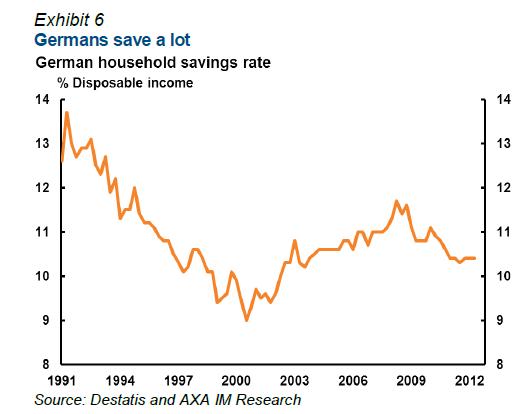

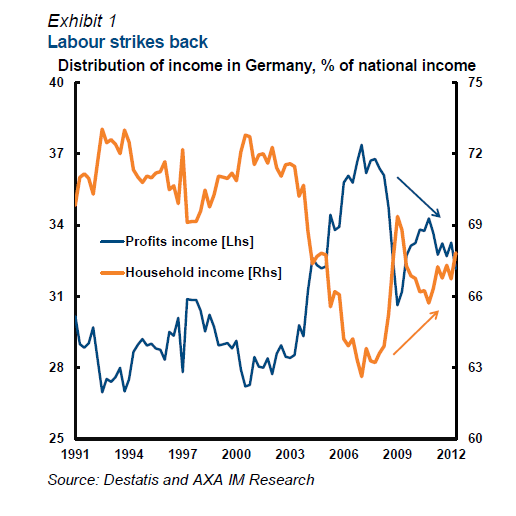
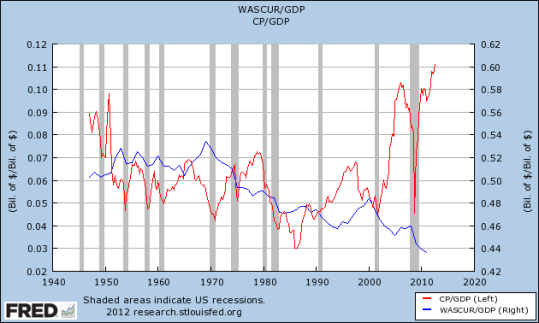
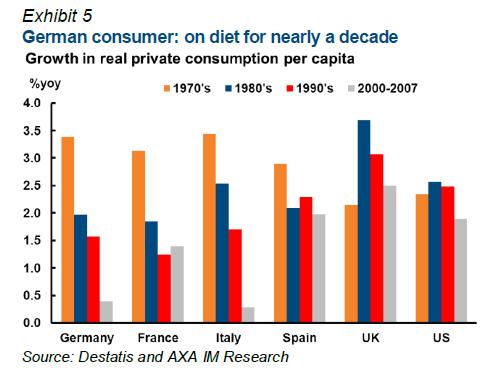
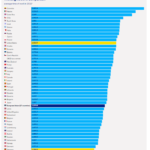
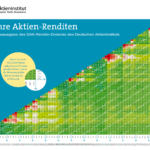
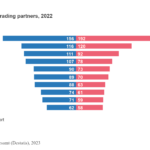
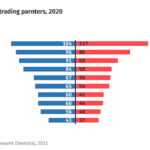
I enjoyed the post, especially the term “socialist”, hey this true, and >70% of the whole world tax literature is written in German. It makes rather a big difference if you eat your Bratwurst sitting or standing. 🙂
Thanks for your comment.
Most of the world tax literature to me looks Greek including the US one.
I prefer sitting and eating rather than standing and eating.
Germany is no more or less economically socialistic than the US is, overall. Both are mixed capitalist countries. As is every country in Europe.
Jonathan
I agree with your comment. Germany and the US are both mixed capitalist countries but a few countries in Europe are more economically socialist than others.
-David
Great post – I am working on identifying how we can guide US consumers to be more European minded regarding consumption for the health of the environment. I read US GDP is 2/3 composed of US consumer spending? It appears if we incentive or inspire US consumers to save more like Germans this could work? Even is its just 3% to 6% savings initially with a goal of 10% over time of disposable earnings. So if US GDP was 20 Trillion in 2018 and US Income was 17 Trillion – then would this mean 13 Trillion was US Consumption and 7 Trillion was exports? Is that right? So if we took 3% away from the 13 Trillion for savings this would be approx 4 Billion – which could be made up with more exports?? or maybe – do you know household spending for everyone – as in I am curious b/c the delta of corporate profit vs wage growth – are higher earning households actually spending less of their disposable income then lower income households? I would imagine so – thats the trend I did read about in Europe – as in Spanish people buy more german cars then germans buy spanish wine…this is interesting right? whats the answer – asking for a friend 😉
Great questions. First of all I am not sure if Americans can be incentivized to save like Germans. The US is a consumption based society and from state policies to culture consumption is given the first priority and not saving. I do not know household spending for everyone. But your guess is correct. Higher income households spend less of their disp. income than lower income households. Thanks for the comment.